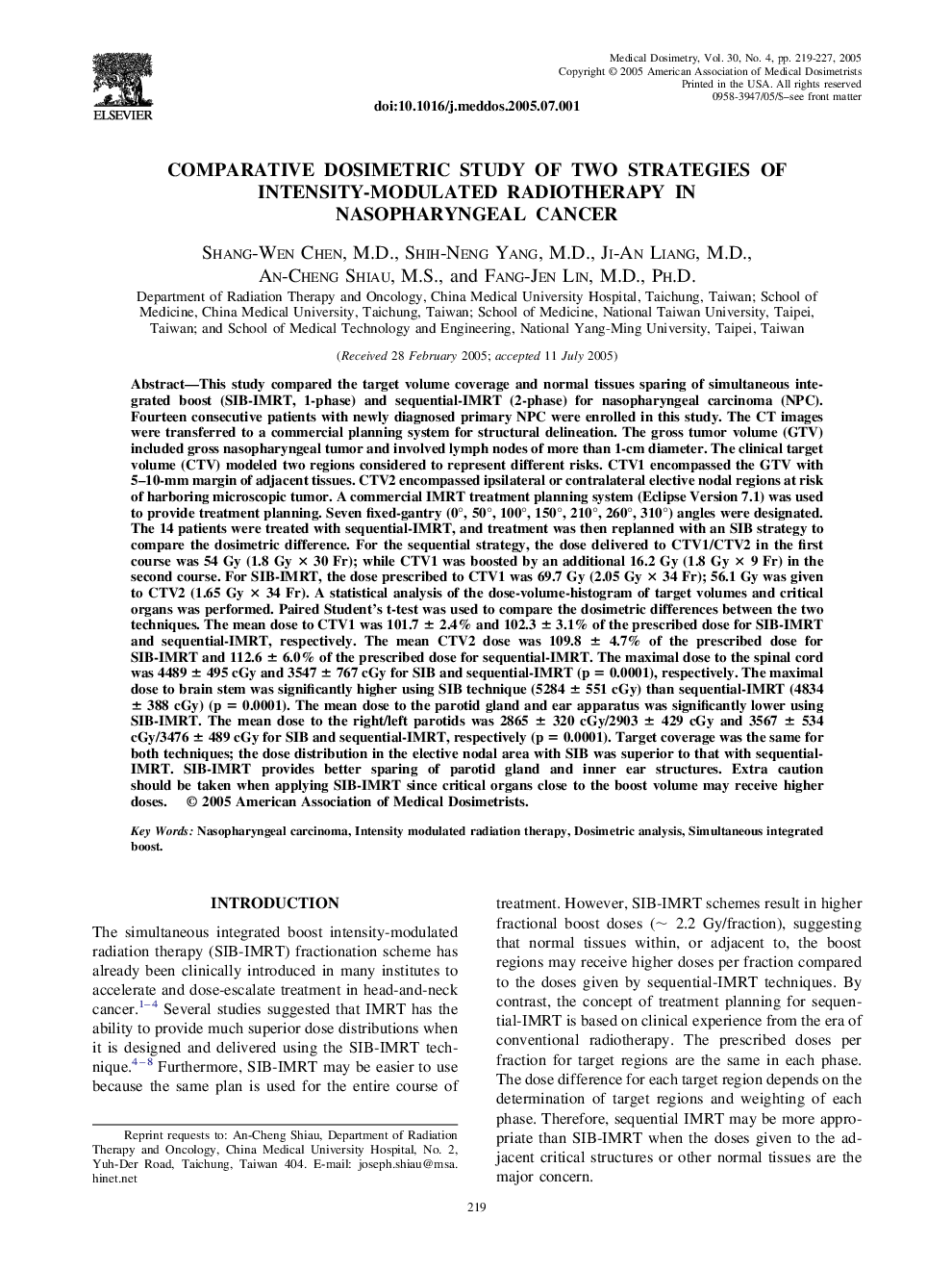| کد مقاله | کد نشریه | سال انتشار | مقاله انگلیسی | نسخه تمام متن |
|---|---|---|---|---|
| 9875863 | 1533331 | 2005 | 9 صفحه PDF | دانلود رایگان |
عنوان انگلیسی مقاله ISI
Comparative dosimetric study of two strategies of intensity-modulated radiotherapy in nasopharyngeal cancer
دانلود مقاله + سفارش ترجمه
دانلود مقاله ISI انگلیسی
رایگان برای ایرانیان
کلمات کلیدی
موضوعات مرتبط
مهندسی و علوم پایه
فیزیک و نجوم
تشعشع
پیش نمایش صفحه اول مقاله

چکیده انگلیسی
This study compared the target volume coverage and normal tissues sparing of simultaneous integrated boost (SIB-IMRT, 1-phase) and sequential-IMRT (2-phase) for nasopharyngeal carcinoma (NPC). Fourteen consecutive patients with newly diagnosed primary NPC were enrolled in this study. The CT images were transferred to a commercial planning system for structural delineation. The gross tumor volume (GTV) included gross nasopharyngeal tumor and involved lymph nodes of more than 1-cm diameter. The clinical target volume (CTV) modeled two regions considered to represent different risks. CTV1 encompassed the GTV with 5-10-mm margin of adjacent tissues. CTV2 encompassed ipsilateral or contralateral elective nodal regions at risk of harboring microscopic tumor. A commercial IMRT treatment planning system (Eclipse Version 7.1) was used to provide treatment planning. Seven fixed-gantry (0°, 50°, 100°, 150°, 210°, 260°, 310°) angles were designated. The 14 patients were treated with sequential-IMRT, and treatment was then replanned with an SIB strategy to compare the dosimetric difference. For the sequential strategy, the dose delivered to CTV1/CTV2 in the first course was 54 Gy (1.8 Gy à 30 Fr); while CTV1 was boosted by an additional 16.2 Gy (1.8 Gy à 9 Fr) in the second course. For SIB-IMRT, the dose prescribed to CTV1 was 69.7 Gy (2.05 Gy à 34 Fr); 56.1 Gy was given to CTV2 (1.65 Gy à 34 Fr). A statistical analysis of the dose-volume-histogram of target volumes and critical organs was performed. Paired Student's t-test was used to compare the dosimetric differences between the two techniques. The mean dose to CTV1 was 101.7 ± 2.4% and 102.3 ± 3.1% of the prescribed dose for SIB-IMRT and sequential-IMRT, respectively. The mean CTV2 dose was 109.8 ± 4.7% of the prescribed dose for SIB-IMRT and 112.6 ± 6.0% of the prescribed dose for sequential-IMRT. The maximal dose to the spinal cord was 4489 ± 495 cGy and 3547 ± 767 cGy for SIB and sequential-IMRT (p = 0.0001), respectively. The maximal dose to brain stem was significantly higher using SIB technique (5284 ± 551 cGy) than sequential-IMRT (4834 ± 388 cGy) (p = 0.0001). The mean dose to the parotid gland and ear apparatus was significantly lower using SIB-IMRT. The mean dose to the right/left parotids was 2865 ± 320 cGy/2903 ± 429 cGy and 3567 ± 534 cGy/3476 ± 489 cGy for SIB and sequential-IMRT, respectively (p = 0.0001). Target coverage was the same for both techniques; the dose distribution in the elective nodal area with SIB was superior to that with sequential-IMRT. SIB-IMRT provides better sparing of parotid gland and inner ear structures. Extra caution should be taken when applying SIB-IMRT since critical organs close to the boost volume may receive higher doses.
ناشر
Database: Elsevier - ScienceDirect (ساینس دایرکت)
Journal: Medical Dosimetry - Volume 30, Issue 4, Winter 2005, Pages 219-227
Journal: Medical Dosimetry - Volume 30, Issue 4, Winter 2005, Pages 219-227
نویسندگان
Shang-Wen M.D., Shih-Neng M.D., Ji-An M.D., An-Cheng M.S., Fang-Jen M.D., Ph.D.,